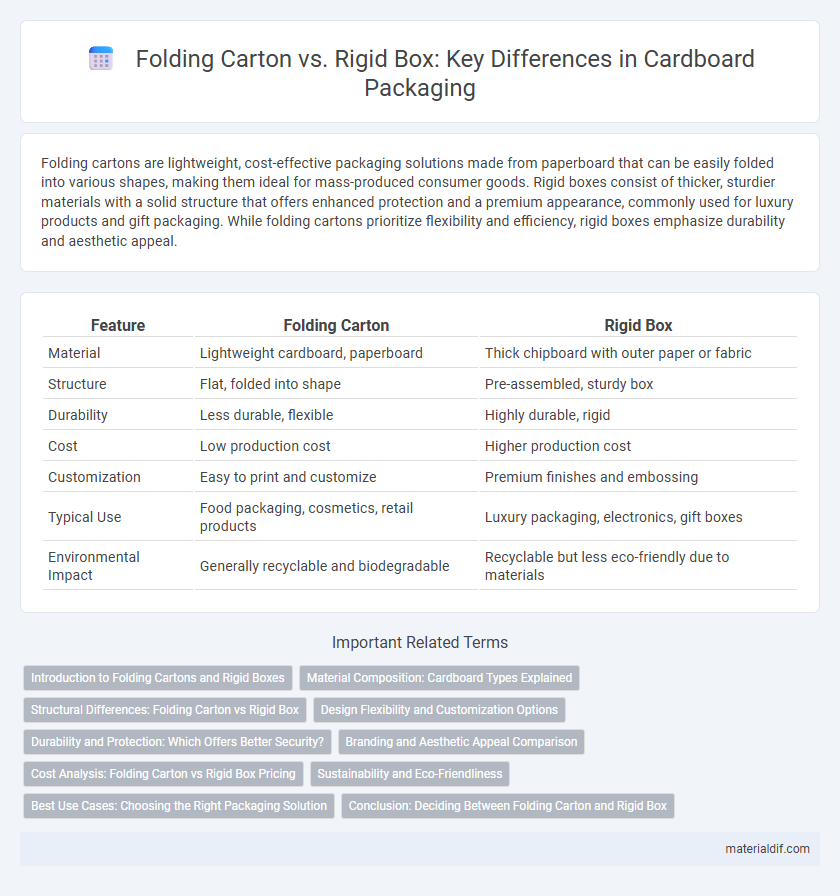Folding cartons are lightweight, cost-effective packaging solutions made from paperboard that can be easily folded into various shapes, making them ideal for mass-produced consumer goods. Rigid boxes consist of thicker, sturdier materials with a solid structure that offers enhanced protection and a premium appearance, commonly used for luxury products and gift packaging. While folding cartons prioritize flexibility and efficiency, rigid boxes emphasize durability and aesthetic appeal.
Table of Comparison
| Feature | Folding Carton | Rigid Box |
|---|---|---|
| Material | Lightweight cardboard, paperboard | Thick chipboard with outer paper or fabric |
| Structure | Flat, folded into shape | Pre-assembled, sturdy box |
| Durability | Less durable, flexible | Highly durable, rigid |
| Cost | Low production cost | Higher production cost |
| Customization | Easy to print and customize | Premium finishes and embossing |
| Typical Use | Food packaging, cosmetics, retail products | Luxury packaging, electronics, gift boxes |
| Environmental Impact | Generally recyclable and biodegradable | Recyclable but less eco-friendly due to materials |
Introduction to Folding Cartons and Rigid Boxes
Folding cartons are lightweight packaging solutions made from paperboard that can be easily folded into shape, offering cost-effective and versatile options for consumer goods. Rigid boxes consist of thick, inflexible board materials that provide superior protection and a premium presentation, commonly used for luxury products. Both packaging types serve distinct roles in the market, with folding cartons prioritizing convenience and rigid boxes emphasizing durability and aesthetics.
Material Composition: Cardboard Types Explained
Folding cartons are made from paperboard, typically consisting of a single-layered cardboard that is lightweight and flexible, ideal for easy folding and assembly. Rigid boxes use thicker, multi-layered chipboard or grayboard covered with decorative paper or fabric, providing enhanced durability and a premium feel. The material composition significantly impacts the packaging's strength, protection level, and cost, making cardboard type a key consideration in packaging design.
Structural Differences: Folding Carton vs Rigid Box
Folding cartons are constructed from single-paperboard sheets that are scored, folded, and glued, allowing for efficient flat storage and assembly upon use. Rigid boxes consist of thick, thickened chipboard or paperboard layers covered with decorative paper or fabric, offering superior durability and a sturdy structure that does not collapse. The main structural difference lies in folding cartons' collapsibility and lightweight nature compared to the solid, non-collapsible build of rigid boxes.
Design Flexibility and Customization Options
Folding cartons offer greater design flexibility with their ability to be easily cut, creased, and printed on multiple surfaces, accommodating intricate shapes and vibrant graphics. Rigid boxes, though less adaptable in structure, provide premium customization options such as embossing, debossing, foil stamping, and magnetic closures that enhance tactile appeal and perceived value. Brands seeking highly customizable visual impact often prefer folding cartons, while those emphasizing luxury and durability lean toward rigid boxes.
Durability and Protection: Which Offers Better Security?
Rigid boxes provide superior durability and protection compared to folding cartons due to their solid construction and thicker materials, making them ideal for high-value or fragile items. Folding cartons, while more lightweight and cost-effective, offer moderate protection suitable for less fragile products and short-term storage. For maximum security and impact resistance, rigid boxes are the preferred choice in packaging solutions.
Branding and Aesthetic Appeal Comparison
Folding cartons offer versatile printing options and vibrant graphics that enhance brand visibility with cost-effective customization for fast product turnover. Rigid boxes provide a premium, sturdy structure with a luxurious tactile experience, elevating perceived value and reinforcing high-end brand identity. The choice impacts aesthetic appeal significantly, as rigid boxes convey exclusivity while folding cartons maximize shelf presence with dynamic design flexibility.
Cost Analysis: Folding Carton vs Rigid Box Pricing
Folding cartons typically offer a lower cost per unit compared to rigid boxes due to simpler manufacturing processes and reduced material usage, making them ideal for high-volume packaging needs. Rigid boxes demand higher upfront investment because of thicker materials and intricate assembly, resulting in increased production costs that are justified by premium product presentation. Brands must weigh the cost-effectiveness of folding cartons against the luxury appeal and durability that rigid boxes provide to determine the best packaging solution for their budget and market positioning.
Sustainability and Eco-Friendliness
Folding cartons offer superior sustainability due to their lightweight, recyclable corrugated fiberboard construction, reducing material waste and carbon footprint during production and transportation. Rigid boxes, often made with non-recyclable components and heavier materials, tend to have a larger environmental impact despite their durability. Choosing folding cartons supports eco-friendly packaging practices by optimizing resource efficiency and end-of-life recyclability.
Best Use Cases: Choosing the Right Packaging Solution
Folding cartons excel in cost-effective, lightweight packaging suitable for fast-moving consumer goods like cosmetics, pharmaceuticals, and food products requiring quick assembly and easy customization. Rigid boxes provide premium, durable protection ideal for luxury items such as electronics, jewelry, and high-end retail products demanding enhanced structural integrity and upscale presentation. Selecting between folding cartons and rigid boxes depends on balancing budget constraints with product protection needs and brand positioning strategies.
Conclusion: Deciding Between Folding Carton and Rigid Box
Choosing between folding cartons and rigid boxes depends on product protection needs, presentation quality, and budget constraints. Folding cartons offer cost-efficiency, lightweight design, and easy customization, ideal for mass-market goods requiring moderate protection. Rigid boxes provide superior durability, premium appearance, and structural integrity, making them suitable for luxury items and high-end packaging requirements.
Folding carton vs Rigid box Infographic

 materialdif.com
materialdif.com